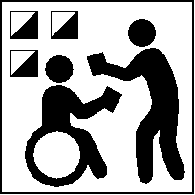- Trail orienteering
Sport

imagesize = 212px
caption = Trail orienteering logo
union = International Orienteering Federation
nickname =
first =
registered =
clubs =
contact = Non-contact
team = Individual
mgender = Separate categories
category = Outdoor
ball =
olympic =Trail orienteering (trail-O, also precision orienteering) is an
orienteering sport that involves precise reading of anorienteering map and the corresponding terrain. Trail orienteers must identify, in the terrain and in the presence ofdecoy s, control points shown on the map. Trail-O involvesnavigation skills but unlike most other forms of orienteering, it involves nopoint to point racing and little or no route choice. It is conducted usually on trails and because the objective is accuracy, not speed, the sport is accessible to physicallydisabled competitors on equal terms as able-bodied.Trail-O is one of four orienteering sports sanctioned by the
International Orienteering Federation (IOF). European Championships in trail orienteering have been organised every year since 1994. The first ever World Cup in trail orienteering was held in 1999, and the inaugural World Trail Orienteering Championships were organised in 2004. The World Championships is organised every year.Trail-O has been developed to offer everyone, including people with limited mobility, a chance to participate in a meaningful orienteering competition. Because control points are identified from a distance, and competitors are not allowed to leave the designated course, participants with and without physical disabilities compete on level terms. [http://www.orienteering.org/i3/index.php?/iof2006/content/view/full/1046 Trail Orienteering / Disciplines / Top - International Orienteering Federation ] ]
Mobility aids
Apart from a combustion-engine vehicle, any recognised mobility aids are permitted. Requested physical assistance is also permitted.
Map
The orienteering map is usually at 1:5000 or 1:4000 scale. [cite web |url= http://www.trailo.org/|title= TRAIL ORIENTEERING|accessdate=2008-05-26 |publisher= Don Braggins|date=2007-09-10]
Control card
The competitor uses a multiple-choice control card and interprets the map to choose which one of the control markers in the terrain represents the one marked at the map. In Elite Trail Orienteering, also none of the markers could be correct, leading to the answer "Zero". A less common form involves determining the position on a map of a control viewed from a set point 30 – 40 metres away.
References
External Links
* [http://www.trailo.org/ TrailO.org]
Wikimedia Foundation. 2010.
